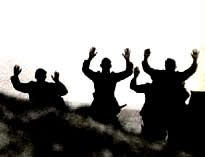 The hierarchy of
the Archdiocese of Goa must not know what has hit it. While used to accolades
from the leadership of the Nagari Konkani movement, more recently the same
leadership has been subjecting the Archdiocese to the most vicious attacks. A
month ago Naguesh Karmali
made the bold suggestion that the Catholic Church in Goa was suppressing
Indian culture in a manner that exceeded that of the sixteenth and seventeenth
century Portuguese. Uday Bhembre has directed ire against the Catholic Church
on other occasions. For his part, Raju Nayak, editor of the Marathi daily Lokmat, indicated that the Archbishop’s
choice to address his guests at the Christmas reception in English rather than
Konkani demonstrated a certain lack of Indian-ness of the Catholic Church in
Goa.
The hierarchy of
the Archdiocese of Goa must not know what has hit it. While used to accolades
from the leadership of the Nagari Konkani movement, more recently the same
leadership has been subjecting the Archdiocese to the most vicious attacks. A
month ago Naguesh Karmali
made the bold suggestion that the Catholic Church in Goa was suppressing
Indian culture in a manner that exceeded that of the sixteenth and seventeenth
century Portuguese. Uday Bhembre has directed ire against the Catholic Church
on other occasions. For his part, Raju Nayak, editor of the Marathi daily Lokmat, indicated that the Archbishop’s
choice to address his guests at the Christmas reception in English rather than
Konkani demonstrated a certain lack of Indian-ness of the Catholic Church in
Goa. In this column I
would like to examine the manner in which Sandesh Prabhudesai, another Konkani
stalwart, positions the Church in his book Clear
Cut: Goa behind the Glamour (2014). Clear
Cut is a collection of the op-eds Prabhudesai has written over a period of
years. While the writing is uneven it nevertheless demonstrates the nature of
his concerns, the most constant of which is securing a Goan identity through Konkani.
In this column I
would like to examine the manner in which Sandesh Prabhudesai, another Konkani
stalwart, positions the Church in his book Clear
Cut: Goa behind the Glamour (2014). Clear
Cut is a collection of the op-eds Prabhudesai has written over a period of
years. While the writing is uneven it nevertheless demonstrates the nature of
his concerns, the most constant of which is securing a Goan identity through Konkani.
Reading
Prabhudesai’s musings, one gets a sense of his opinion of the Catholic Church.
Take, for example, the following sentence from the article ‘Medium of
Destruction’ (p. 20), written originally on 29 March 2011. Not explicitly
referring to the schools managed by the Archdiocese, he says that “the Konkani
medium has been ‘exploited’ purely to get salary grants for the teachers and
not to impart education in proper Konkani” (p. 21). Nonetheless, he admits in another
article titled ‘What does Parrikar's MoI Policy Mean?’ (originally written in
2012 ) that “only Konkani medium schools run by the Church are shifting to
English medium” (p. 35). What Prabhudesai seems to be suggesting, therefore, is
that the Konkani medium was “exploited” by the Archdiocese way back in 1990, and
that the Archdiocese had no inherent love for Konkani, but switched to Konkani
only to financially sustain its schools. Incidentally, his suggestion is not
very different from that of the opinion expressed by Raju Nayak in his recent
editorial, who went so far as to suggest that the Archdiocese was in fact in
favour of English right from the very beginning. Indeed, if one reads Clear Cut carefully, one is struck by
the similarity between Nayak’s opinion and Prabhudesai’s as regards the
Archdiocese’s relationship to Konkani.
 What one gets
from these writings, is of the Archdiocese as a manipulative institution. The
idea of a manipulative Archdiocese is further elaborated in ‘What does Parrikar’s
MoI Policy Mean?’ Here Prabhudesai writes: “As expected, Chief Minister Manohar
Parrikar followed the suit [sic] of his
predecessor Digambar Kamat and surrendered his Bharatiya Janata Party (BJP)
before the Church, to work out a ‘political’ solution to the long-pending
controversy over Medium of Instruction (MoI).” The critical words to focus on
here are “surrendered…before the Church”. There are a number of objectives that
Prabhudesai seems to accomplish in this one phrase.
What one gets
from these writings, is of the Archdiocese as a manipulative institution. The
idea of a manipulative Archdiocese is further elaborated in ‘What does Parrikar’s
MoI Policy Mean?’ Here Prabhudesai writes: “As expected, Chief Minister Manohar
Parrikar followed the suit [sic] of his
predecessor Digambar Kamat and surrendered his Bharatiya Janata Party (BJP)
before the Church, to work out a ‘political’ solution to the long-pending
controversy over Medium of Instruction (MoI).” The critical words to focus on
here are “surrendered…before the Church”. There are a number of objectives that
Prabhudesai seems to accomplish in this one phrase.
The first
objective is that these words seem to suggest that the Archdiocese is an
institution that can make or break governmental decisions whenever it wishes. To
suggest that the Catholic Church is a major force in local politics is a common
trope in Goan reportage. While it sometimes enjoys this power, this is not
always the case. The fact is that the Catholic Church in Goa, just as in India,
is in fact pinned, as it has been for some decades now, in the grip of Hindu
majoritarian politics. All too often, as has been the case of the Archdiocese’s
action in the post-colonial history of the Konkani language, the Archdiocese
has gone out of its way, and in fact contrary to the wishes of many Catholics, to please the leaders of the Nagari Konkani
establishment.
 The second
objective of the use of “surrender” seems to be Prabhudesai’s intention to
shame the BJP into pursuing the anti-minority position that they are popularly identified
with. Prabhudesai’s recourse to this strategy of shaming is particularly troublesome
because it appears to insist that the BJP not respond pragmatically, but hold
on, come hell or high water, to its ideological position. Using the metaphor of a war, tt seeks to provoke
the rank and file to shame and anger so that they may prevail on their
leadership.
The second
objective of the use of “surrender” seems to be Prabhudesai’s intention to
shame the BJP into pursuing the anti-minority position that they are popularly identified
with. Prabhudesai’s recourse to this strategy of shaming is particularly troublesome
because it appears to insist that the BJP not respond pragmatically, but hold
on, come hell or high water, to its ideological position. Using the metaphor of a war, tt seeks to provoke
the rank and file to shame and anger so that they may prevail on their
leadership. Even more
important, this phrase suggesting surrender seems to ignore the fact that the power-brokers
of the Archdiocese are not acting on their own accord, but rather responding to
the firm demands of hundreds, if not thousands of bahujan Catholics have
indicated in no uncertain terms that they wish to have their children educated
in English, not the brahmanised Nagari Konkani invented early in the twentieth
century. Left to themselves, I have no doubt that the brahamnical leadership of
the Archdiocese would have continued to pander to their brahmin cousins in the
Nagari leadership. If Parrikar were surrendering, therefore, he would have been
surrendering before the wishes of citizens represented in this case by the
Archdiocese. No shame in this. Once
again, this denial that the Diocesan leadership is in fact acting in line with
the desires of large sections of the laity, is a line taken more recently by
Nayak.
Even more
important, this phrase suggesting surrender seems to ignore the fact that the power-brokers
of the Archdiocese are not acting on their own accord, but rather responding to
the firm demands of hundreds, if not thousands of bahujan Catholics have
indicated in no uncertain terms that they wish to have their children educated
in English, not the brahmanised Nagari Konkani invented early in the twentieth
century. Left to themselves, I have no doubt that the brahamnical leadership of
the Archdiocese would have continued to pander to their brahmin cousins in the
Nagari leadership. If Parrikar were surrendering, therefore, he would have been
surrendering before the wishes of citizens represented in this case by the
Archdiocese. No shame in this. Once
again, this denial that the Diocesan leadership is in fact acting in line with
the desires of large sections of the laity, is a line taken more recently by
Nayak.
It should be
observed that I am not engaging in a blanket defence of the actions of the
Archdiocesan leadership. There is much evidence to suggest that all is not well
in many cases of the sale of church properties. Even if made in good faith, the
fact is that various groups within the Church in Goa do not see eye to eye on
the issue of the sale of properties. What is interesting, however, is that
Prabhudesai, in particular, does not seem to problematize this democracy
deficit in operation of the Archdiocese. His single point of critique is
limited to his understanding of the Konkani issue.
In a recent
op-ed taking issue with Nayak’s editorial, Kaustubh
Naik suggests that Nayak’s stance denies “the minorities the agency to make
their own life choices”. Naik is spot on in this analysis. In portraying the
Church as a manipulative and dictatorial institution, and seeking to shame
Parrikar for negotiating with the Archdiocese, what Prabhudesai appears to do
is to prevent Catholic groups in Goa from using the Archdiocese as one more
representational body to get their legitimate rights recognized by the
government. Indeed, the thought of shame gains traction only if there is the
suggestion that the Church or Archdiocese has no legitimacy being an actor, or representing
Goan Catholics, in Goan politics. As the recent shenanigans of the BBSM
demonstrates, politics is not determined solely by the ballot. In such a
circumstance, there is no harm in the Goan Catholics utilising the structures
of the Archdiocese to organise and articulate their demands. In denying them
this choice, Prabhudesai denies political agency, or choice, to the Catholic
communities in Goa, forcing them into a field that is dominated entirely by
apparently secular liberal, or soft Hindutva rhetoric and politics; a politics
that Sandesh Prabhudesai seems to subscribe to.
(A version of this post was first published in the OHeraldo on 8 Jan 210)

No comments:
Post a Comment